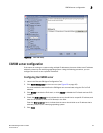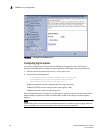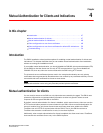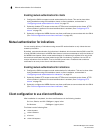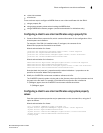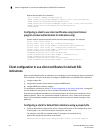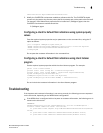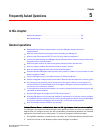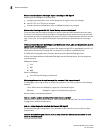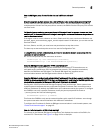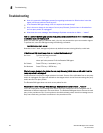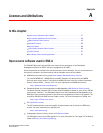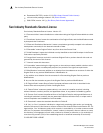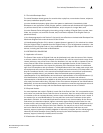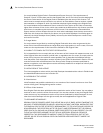
Brocade SMI Agent User’s Guide 53
53-1001778-01
Chapter
5
Frequently Asked Questions
In this chapter
•General questions . . . . . . . . . . . . . . . . . . . . . . . . . . . . . . . . . . . . . . . . . . . . . . 53
•Troubleshooting . . . . . . . . . . . . . . . . . . . . . . . . . . . . . . . . . . . . . . . . . . . . . . . . 56
General questions
• Besides Windows Domain authentication, does the SMI Agent support local user
authentication?
• What are some situations that might require restarting the SMI Agent?
• What are the Eventing and ARR TCP Ports? Do they relate to indications?
• If I have a firewall between the SMIAgent and the Brocade switch, what are the ports that must
be opened and in which direction?
• What encryption method is used to encrypt the password field in provider.xml?
• How do I report a problem and what information should I provide?
• How do I collect diagnostic data from the Brocade SMI Agent?
• Does the Brocade SMI Agent need to point to every switch in a fabric or just one switch in each
fabric to collect the data?
• Can the SMI Agent proxy for two fabrics that are in different subnets?
• Should I designate multiple proxies into a fabric? What are the best practices concerning this?
• Do the start_server and stop_server scripts work if the agent is set to run as a daemon on
Linux and Solaris? Do these scripts work if the agent running as a service on Windows or do
you have to use the Services window?
• In using Windows domain authentication, do I need to include the domain name along with the
username for authentication?
• Does the SMI Agent have support for HTTPS communication?
• Does the SMI Agent work on hosts with multiple IP addresses? If so is there a way to configure
the CIMOM to choose a specific NIC/IP? Is there anything special I need to do for the SMI Agent
to see proxy switches connected to the second NIC, or will it just work by default?
• How do I tell what version of SMI-A I am running?
Besides Windows Domain authentication, does the SMI Agent support local user authentication?
The SMI Agent also supports authenticating the user against the system on which it is installed. By
default when you configure security, the user’s credentials (username and password) are validated
against the ones present on the local system. To ensure this happens, follow these steps:
1. During SMI-A installation, enable security and select “No” for Windows domain authentication.
2. Create a local user on the Windows system where the agent is installed.



